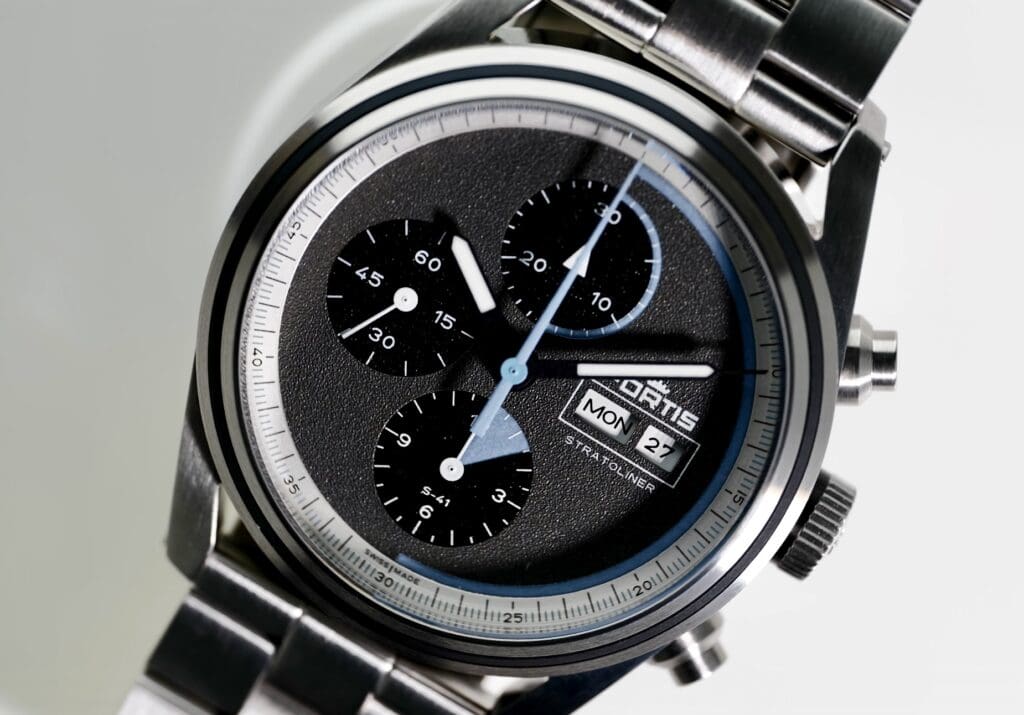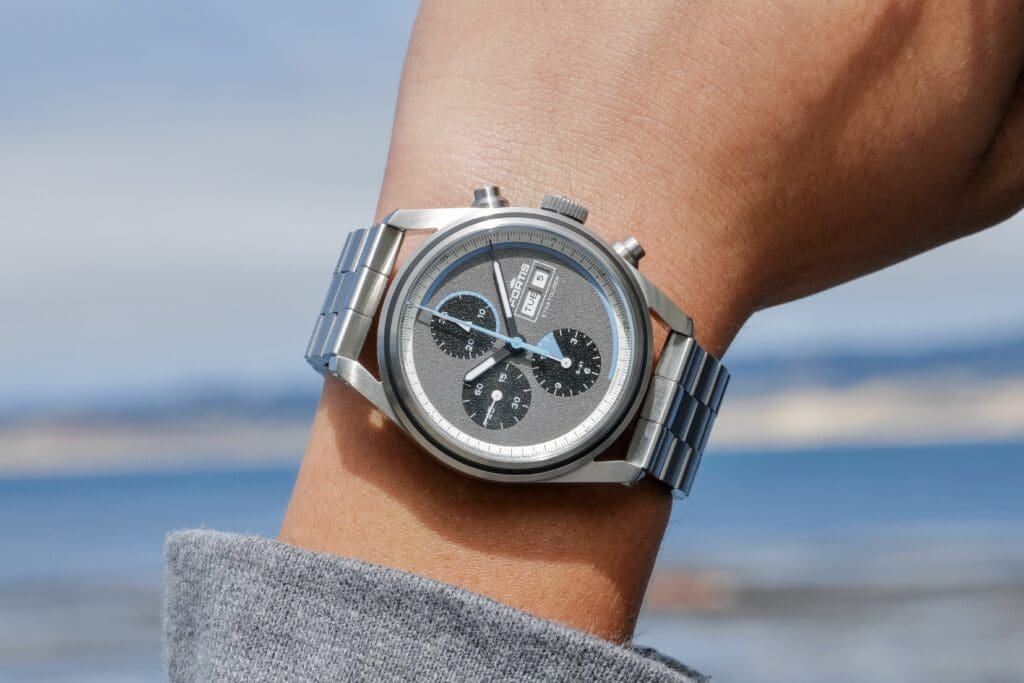We’ve touched on this in previous articles, but Fortis has entered a new era since Jupp Phillip took over several years ago. The new Fortis is rejuvenated and innovative, largely because it’s run by a team of Fortis enthusiasts. However, Fortis is quite a unique brand. It has an extremely rich history in the horological world. John Harwood’s original automatic watch was produced in the very same room where Fortis watches are assembled today in Grenchen, Switzerland. Fortis also has a significant history in space exploration, a legacy only rivaled by two other watchmaking giants, Seiko and Omega.
Background & History
Fortis’s current lineup consists of four major groups. These include the Dive watches, marketed as “the adventure watches” under the name Marinemaster, the classic Flieger Watches and the direct descendant of the Cosmonaut watches, the Novanaut. The fourth group is the distinct Stratoliner.
Since its origin in the 1980s, the Stratoliner for Fortis has meant many different things. It has oscillated between being a dress watch as well as adopting the B-42 case. A standout from the past Stratoliner collection was the collaboration with Mercedes Benz, which featured a B-42 case with the Lemania 5100, a personal favorite of mine. These watches have aged well, with a few examples showcasing beautiful, aged cream-colored dials.

The new S-41 Stratoliner ushers in a new era for the Stratoliner and Fortis. Representing “New Frontiers,” the Stratoliner symbolizes a new and exciting way of thinking and operating at Fortis HQ.
When Jupp Phillip took over the company, he and designer Xavier Perrenoud aimed to create an iconic, distinct piece. They succeeded with the Stratoliner. I’ve grown to appreciate several of Xavier’s designs, including the stunning Armin Strom Gravity Equal Force. The Stratoliner embodies many design cues from which future Fortis watches could draw.
Form Over Function, but Not Really
At first glance, you might notice that the Stratoliner watch’s dial lacks many markings. Despite this, it remains a functional timepiece suitable for both timing events and daily use.
The Stratoliner’s design was inspired by the timing of a Virgin Galactic space launch. While this connection may seem tenuous, it results in a unique dial layout and one of the most distinctive luminescent applications available today. A true stand-out feature of this watch.
The dial layout is straightforward: the sub-dial at the top represents the takeoff phase, the track between the 12 o’clock and 6 o’clock marks signifies the zero-gravity period, and the hours sub-dial filled with Super-Luminova X1 represents the re-entry phase. Although these specific features may not be used in everyday situations, they balance three common time periods—15 minutes, 30 minutes, and 90 minutes—in a visually stunning way. If you think about it, it is quite useful, from timing task management to timing a 90-minute bike ride. I can think of a plethora of ways to use these markings outside of the theoretically intended use of timing an exceptionally expensive plane ride.
Fortis’ bold approach extends to the case design. The Stratoliner’s case is not small or sleek, and its straight lugs are quite prominent. The flat case, which doesn’t conform to the wrist’s curvature, is purposeful and adds to the watch’s unique appeal. Unlike the Novonaut or anything from the Flieger range, the Stratoliner has no end links to bridge the gap between the lugs, strap, or bracelet and case. Although initially striking, this design grows on you over time and looks particularly good on a NATO or similar style strap.
The dial variations on the Stratoliner emphasize simplicity and contrast. They evoke the Bauhaus school of design, and all feature a micro-texture that is especially noticeable on the white dust and Cosmic Grey models. I could easily see this as the antithesis of Bauhaus design translated to a watch like a Nomos or Junghans.

Not your standard Tool Watch
The Fortis Stratoliner is not your standard tool watch, and that’s what sets it apart. We’re in an era where every timepiece seems to resemble a Doxa, a Submariner, or another reboot of a field watch from the ‘dirty dozen’ batch. The market is saturated with these designs, and frankly, it’s becoming monotonous. The watch industry has an abundance of these pieces and faces a pressing issue: the need for innovation to drive sales. There’s only so much demand for vintage reissue watches or submariners with different dials. We need fresh icons, and the Stratoliner addresses this need. It’s unique, bold, and unconventional – exactly the intention Xavier Perrenoud and Jupp Phillip had in mind.
If you’ve been following Matt Wright’s discussions on tool watch icons, both modern and neo-vintage, you’ll know that while I largely agree with him, I think he might be overlooking one here. The Stratoliner is an underappreciated icon in its time that gains recognition and stature as it ages. Like fine wines or famous photographs by Henri Cartier-Bresson or Elliott Erwitt, icons need time to mature to be fully appreciated. Concepts that are truly worth understanding often aren’t easily digestible at first.

Wrap Up
The Fortis Stratoliner remains a proudly functional tooly tool watch. It’s large, bold, and striking but also complex and subtly designed. It signifies something truly different in the tool watch space. Just like those “Not Another Sprinter” bumper stickers seen on campers and jeeps at my local trailheads, this watch isn’t another “Daytona” or “Speedmaster.” It is uniquely a Fortis, and I respect and love it for that.
The Fortis Stratoliner and the full lineup of Fortis watches are available at CW Watch Shop.
Benjamin Carpenter



